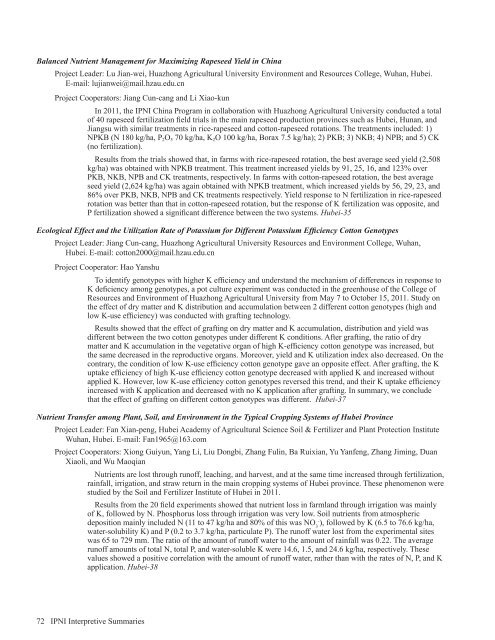Americas and Oceania Group - International Plant Nutrition Institute
Americas and Oceania Group - International Plant Nutrition Institute
Americas and Oceania Group - International Plant Nutrition Institute
Create successful ePaper yourself
Turn your PDF publications into a flip-book with our unique Google optimized e-Paper software.
Balanced Nutrient Management for Maximizing Rapeseed Yield in China<br />
Project Leader: Lu Jian-wei, Huazhong Agricultural University Environment <strong>and</strong> Resources College, Wuhan, Hubei.<br />
E-mail: lujianwei@mail.hzau.edu.cn<br />
Project Cooperators: Jiang Cun-cang <strong>and</strong> Li Xiao-kun<br />
In 2011, the IPNI China Program in collaboration with Huazhong Agricultural University conducted a total<br />
of 40 rapeseed fertilization field trials in the main rapeseed production provinces such as Hubei, Hunan, <strong>and</strong><br />
Jiangsu with similar treatments in rice-rapeseed <strong>and</strong> cotton-rapeseed rotations. The treatments included: 1)<br />
NPKB (N 180 kg/ha, P 2 O 5 70 kg/ha, K 2 O 100 kg/ha, Borax 7.5 kg/ha); 2) PKB; 3) NKB; 4) NPB; <strong>and</strong> 5) CK<br />
(no fertilization).<br />
Results from the trials showed that, in farms with rice-rapeseed rotation, the best average seed yield (2,508<br />
kg/ha) was obtained with NPKB treatment. This treatment increased yields by 91, 25, 16, <strong>and</strong> 123% over<br />
PKB, NKB, NPB <strong>and</strong> CK treatments, respectively. In farms with cotton-rapeseed rotation, the best average<br />
seed yield (2,624 kg/ha) was again obtained with NPKB treatment, which increased yields by 56, 29, 23, <strong>and</strong><br />
86% over PKB, NKB, NPB <strong>and</strong> CK treatments respectively. Yield response to N fertilization in rice-rapeseed<br />
rotation was better than that in cotton-rapeseed rotation, but the response of K fertilization was opposite, <strong>and</strong><br />
P fertilization showed a significant difference between the two systems. Hubei-35<br />
Ecological Effect <strong>and</strong> the Utilization Rate of Potassium for Different Potassium Efficiency Cotton Genotypes<br />
Project Leader: Jiang Cun-cang, Huazhong Agricultural University Resources <strong>and</strong> Environment College, Wuhan,<br />
Hubei. E-mail: cotton2000@mail.hzau.edu.cn<br />
Project Cooperator: Hao Yanshu<br />
To identify genotypes with higher K efficiency <strong>and</strong> underst<strong>and</strong> the mechanism of differences in response to<br />
K deficiency among genotypes, a pot culture experiment was conducted in the greenhouse of the College of<br />
Resources <strong>and</strong> Environment of Huazhong Agricultural University from May 7 to October 15, 2011. Study on<br />
the effect of dry matter <strong>and</strong> K distribution <strong>and</strong> accumulation between 2 different cotton genotypes (high <strong>and</strong><br />
low K-use efficiency) was conducted with grafting technology.<br />
Results showed that the effect of grafting on dry matter <strong>and</strong> K accumulation, distribution <strong>and</strong> yield was<br />
different between the two cotton genotypes under different K conditions. After grafting, the ratio of dry<br />
matter <strong>and</strong> K accumulation in the vegetative organ of high K-efficiency cotton genotype was increased, but<br />
the same decreased in the reproductive organs. Moreover, yield <strong>and</strong> K utilization index also decreased. On the<br />
contrary, the condition of low K-use efficiency cotton genotype gave an opposite effect. After grafting, the K<br />
uptake efficiency of high K-use efficiency cotton genotype decreased with applied K <strong>and</strong> increased without<br />
applied K. However, low K-use efficiency cotton genotypes reversed this trend, <strong>and</strong> their K uptake efficiency<br />
increased with K application <strong>and</strong> decreased with no K application after grafting. In summary, we conclude<br />
that the effect of grafting on different cotton genotypes was different. Hubei-37<br />
Nutrient Transfer among <strong>Plant</strong>, Soil, <strong>and</strong> Environment in the Typical Cropping Systems of Hubei Province<br />
Project Leader: Fan Xian-peng, Hubei Academy of Agricultural Science Soil & Fertilizer <strong>and</strong> <strong>Plant</strong> Protection <strong>Institute</strong><br />
Wuhan, Hubei. E-mail: Fan1965@163.com<br />
Project Cooperators: Xiong Guiyun, Yang Li, Liu Dongbi, Zhang Fulin, Ba Ruixian, Yu Yanfeng, Zhang Jiming, Duan<br />
Xiaoli, <strong>and</strong> Wu Maoqian<br />
Nutrients are lost through runoff, leaching, <strong>and</strong> harvest, <strong>and</strong> at the same time increased through fertilization,<br />
rainfall, irrigation, <strong>and</strong> straw return in the main cropping systems of Hubei province. These phenomenon were<br />
studied by the Soil <strong>and</strong> Fertilizer <strong>Institute</strong> of Hubei in 2011.<br />
Results from the 20 field experiments showed that nutrient loss in farml<strong>and</strong> through irrigation was mainly<br />
of K, followed by N. Phosphorus loss through irrigation was very low. Soil nutrients from atmospheric<br />
deposition mainly included N (11 to 47 kg/ha <strong>and</strong> 80% of this was NO 3-<br />
), followed by K (6.5 to 76.6 kg/ha,<br />
water-solubility K) <strong>and</strong> P (0.2 to 3.7 kg/ha, particulate P). The runoff water lost from the experimental sites<br />
was 65 to 729 mm. The ratio of the amount of runoff water to the amount of rainfall was 0.22. The average<br />
runoff amounts of total N, total P, <strong>and</strong> water-soluble K were 14.6, 1.5, <strong>and</strong> 24.6 kg/ha, respectively. These<br />
values showed a positive correlation with the amount of runoff water, rather than with the rates of N, P, <strong>and</strong> K<br />
application. Hubei-38<br />
72 IPNI Interpretive Summaries

















